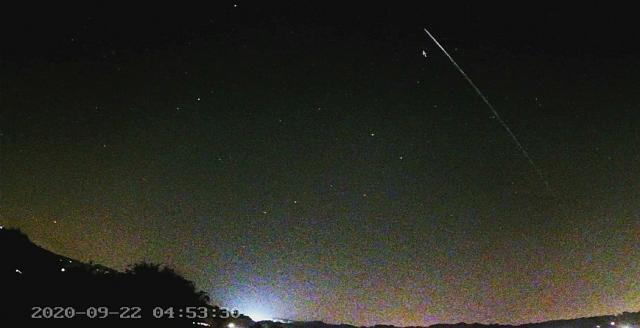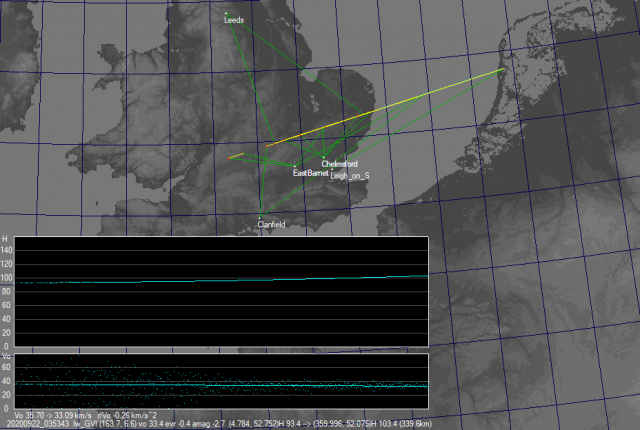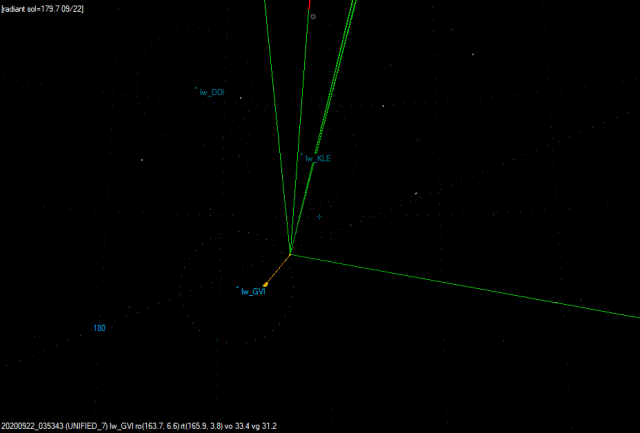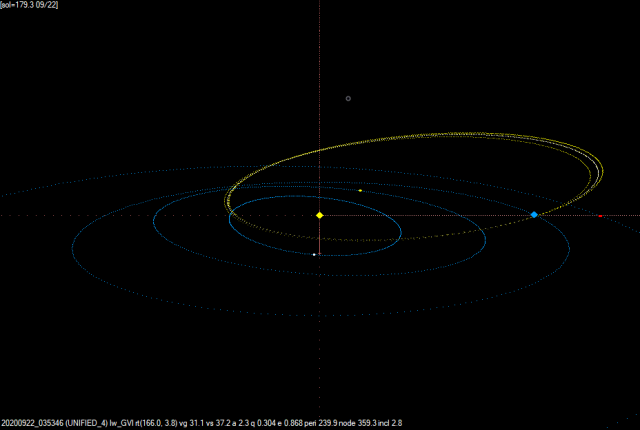- This topic has 2 replies, 3 voices, and was last updated 5 years, 3 months ago by
 Alex Pratt.
Alex Pratt.
-
AuthorPosts
-
25 September 2020 at 4:08 pm #574739
 stan armstrongParticipant
stan armstrongParticipantThis delightfully slow moving Meteor possibly hardly reached Fireball Status, but was seen by well over 100 people over much of Northern Europe. Their comments fascinate me, as does another Quaint Data Input Idiosyncrasy on the IMO Site. I expect the various UKMET Cameras have fed their inputs into NEMETODE and analysis is ongoing, but I could not at first glance find mention of this Event on this Site. Although the Local Golf Club Lights over 1km away and the pre-dawn sky take the edge off this Capture as the meteor increases speed, I am hopeful that it may blend in with other material.

The clock was running around 20secs slow.
Stan
Attachments:
25 September 2020 at 4:49 pm #583170 Dominic FordKeymaster
Dominic FordKeymasterThis was indeed a very beautiful meteor. Two of my meteor cameras caught it, on opposite sides of Cambridge…
https://pigazing.dcford.org.uk/moving_obj.php?id=20200922_035352_b29217a987c61766
https://pigazing.dcford.org.uk/moving_obj.php?id=20200922_035353_ca8e636784ff1d42The times on the Pi Gazing website are all in UTC, in case you’re wondering.
I haven’t got around to doing any triangulation with my data yet, and I also don’t have built a mechanism for exporting data from PiGazing into a format compatible with the larger UK networks. But it sounds like you’ve already got plenty of data for this one! 🙂
25 September 2020 at 5:51 pm #583171 Alex PrattParticipant
Alex PrattParticipantHi Stan,
This object was captured on a few cameras in the NEMETODE video meteor network (UKMON is an independent network based in southern England) and here’s the provisional results from our data recorded by Steve Bosley (Clanfield), Peter Carson (Leigh_on_Sea), Nick James (Chelmsford), myself in Leeds and Jim Rowe (East Barnet). This is its ground track as it travelled from NE to SW (observers in continental Europe recorded the earlier phase of its flyby), e.g. see https://groups.io/g/globalmeteornetwork/message/1366

The mini-plots show it increasing in altitude and slightly decelerating as it crossed over England. (Its absolute mag. of around -2.7 is the magnitude of a meteor at a standardised altitude of 100 km in the observer’s zenith).
Our radiant plot, given below, suggests it might have been a Daytime gamma Virginid (GVI), although that shower is not in the Established List in the IAU MDC.

We obtained a well-defined solar system orbit for the body. The elements have some similarities with a GVI but not fully, perhaps it was a sporadic object. The orbit diagram is here

Analysis of the end phase suggests the object had climbed to 110 km altitude and was slightly accelerating as it faded beyond detection of our video cameras (when it was moving towards the Severn Estuary). At this altitude the meteor would be leaving the ablation layer. So, we surmise that it had a close encounter with Earth and has lived to tell the tale!
Such events aren’t uncommon and at the 2018 Winchester Weekend I described the Earth grazer of 2016 July 16 which took 10s to travel 470 km from the North East to the South coast.
Clear skies,
Alex.
-
AuthorPosts
- You must be logged in to reply to this topic.
